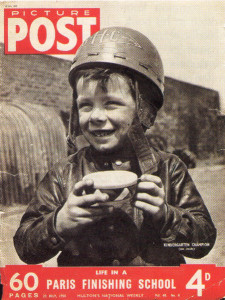 At 6am on a cold and frosty morning in 1953,1 was standing on top of Marble Arch, waiting for the funeral procession of King George VI to begin. I was 15.
At 6am on a cold and frosty morning in 1953,1 was standing on top of Marble Arch, waiting for the funeral procession of King George VI to begin. I was 15.
I was employed by a news agency called Fox Photos, working with a press photographer as his runner boy.
My job was to rush the second batch of pictures taken back to the news agency, just off Fleet Street. The first pictures would have been sent by a dispatch rider to make the morning editions.
Today’s press cameras are electronic and images are posted by satellite direcdy to a receiver in the press room. In 1953, they were 5 inch by 4 inch glass plates, each in its own metal light-proof slide and carried in a leather shoulder bag. All very bulky.
Marble Arch was then used as a police station – with a complement of seven police officers – and stood on the site of Tyburn hanging gallows. Across the top of the arch is one long room which had a roaring coal fire and we were glad to make use of it from time to time, as was a French camera crew who were using a battery-operated cine-camera which had frozen up.
I remember them swearing volubly in French, holding it in front of the fire as the strains of the death march were heard in the distance. They got it operating just in time. The King’s coffin, mounted on a gun carriage and pulled by naval ratings, approached us up Park Lane.
Queen Salote of Tonga was a great hit with the public. Later in the morning, when the cortege was still passing and it began to rain quite heavily, she refused to have the hood up on her Landau and used an umbrella. Her photograph, with umbrella raised, appeared in most papers the following day.
In front of the Odeon cinema, where Park Lane turns the comer into Bay-swater Road, because of the mass of spectators, people couldn’t see very well at the back. Some enterprising
street traders sold thousands of cardboard periscopes. The picture that travelled around the world that day was of the crowd, all turned away from the funeral procession and looking into their periscopes.

When I’d delivered the pictures to Fox Photos, seconds counted.
While the pictures were being processed, a caption writer would compose about four lines to go with the picture selected. About 25 copies were taken on a rotary printer by any boy who was spare. The caption was then stuck on the back of the print, and woe betide whoever was responsible if the caption was late.
To get your pictures to the newspapers quickly, they were sent still damp from processing. We were competing with other news agencies: Associated British Press, Keystone, Reuters are some I recall. To beat other agency lads to the picture editor’s desk, dirty deeds were used to get your pictures there ahead of the others.
If a boy was in front of you delivering to the Evening Standard, you flipped the lift gate open, leaving him stranded halfway up, while you ran up the stairs with your pictures. If you were in front of him at the Daily Express, you put the lift on hold, while you made youi delivery to the picture editor.
All the picture editors had theii idiosyncrasies. If you dared take a picture oi royalty to the Daily Worker, you’d get il thrown back at you, torn in half. At the Evening Standard, the editor, when starting his day, always laid out ten cigarettes in a row on his desk. I’m sure, by the nicotine stains on his fingers, this was only half his daily intake.
Returning to the news room you sat on 2 hard wooden bench, waiting to run errands or scoot down to the press cafe.
The following day, our news manager would search through all the dailies to mart any successes we’d had. Payment was £5 for a front page photograph and £3 for an inside page, with smaller sums for weekly magazines. This was the lifeblood of the agency. Ii you had a picture that went worldwide everyone was ecstatic.
The newsprint world is shrinking. Gone are many great names: The Herald, The Sketch The Graphic, The Chronicle, Reynolds News, Th Evening Star. The list goes on; right back tc the Illustrated London News and the Pictun Post. I ran pictures to them all, enjoying the hustle and bustle of each day. Each newspaper was different but all were dedicated tc making news.
B.D. Kerry








